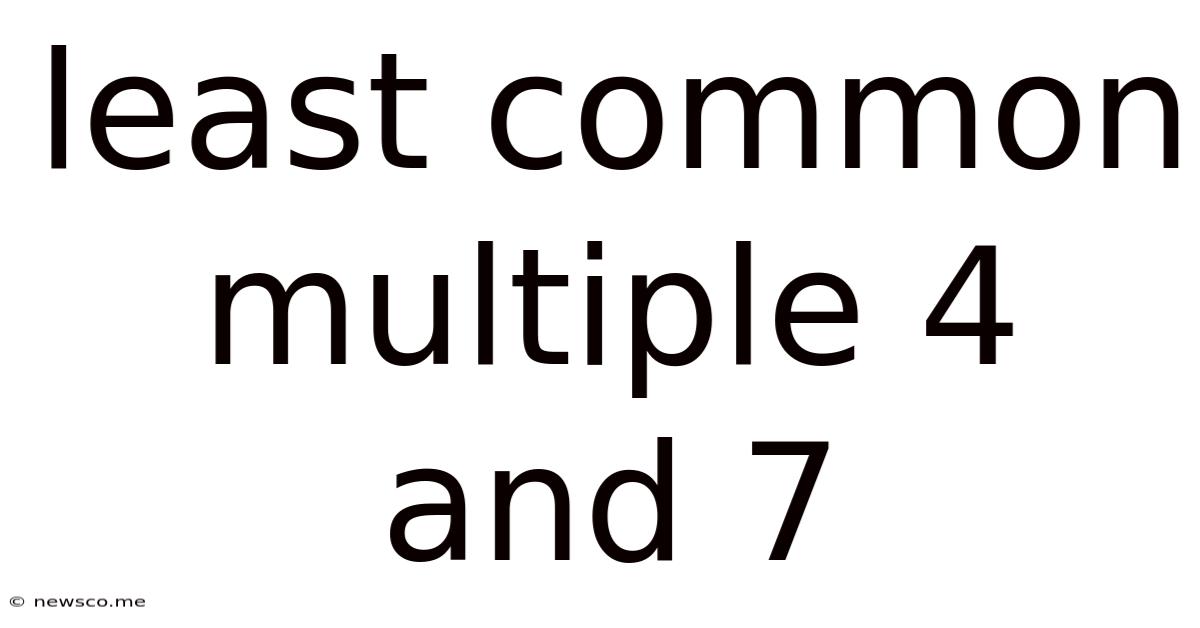Least Common Multiple 4 And 7
News Co
Apr 12, 2025 · 4 min read

Table of Contents
Understanding the Least Common Multiple (LCM) of 4 and 7
The least common multiple (LCM) is a fundamental concept in mathematics, particularly in number theory and algebra. It finds applications in various fields, from scheduling problems to simplifying fractions. This article delves deep into the LCM, specifically focusing on the LCM of 4 and 7, explaining the concept, different methods for calculation, and showcasing its practical implications.
What is the Least Common Multiple (LCM)?
The least common multiple (LCM) of two or more integers is the smallest positive integer that is a multiple of all the integers. In simpler terms, it's the smallest number that can be divided evenly by all the given numbers without leaving a remainder. For example, the LCM of 2 and 3 is 6 because 6 is the smallest positive integer divisible by both 2 and 3.
Finding the LCM of 4 and 7: Different Approaches
Several methods exist for determining the LCM of two or more numbers. Let's explore the most common ones, applying them to find the LCM of 4 and 7.
1. Listing Multiples Method
This is a straightforward method, especially suitable for smaller numbers. We list the multiples of each number until we find the smallest common multiple.
- Multiples of 4: 4, 8, 12, 16, 20, 24, 28, 32, 36...
- Multiples of 7: 7, 14, 21, 28, 35, 42...
By comparing the two lists, we observe that the smallest common multiple is 28. Therefore, the LCM(4, 7) = 28.
2. Prime Factorization Method
This method is more efficient for larger numbers. We find the prime factorization of each number and then construct the LCM using the highest powers of all prime factors present.
- Prime factorization of 4: 2²
- Prime factorization of 7: 7¹ (7 is a prime number)
To find the LCM, we take the highest power of each prime factor present in the factorizations: 2² and 7¹. Multiplying these together, we get:
LCM(4, 7) = 2² * 7 = 4 * 7 = 28
3. Greatest Common Divisor (GCD) Method
The LCM and GCD (Greatest Common Divisor) of two numbers are related by the following formula:
LCM(a, b) * GCD(a, b) = a * b
First, we find the GCD of 4 and 7 using the Euclidean algorithm or prime factorization. The GCD(4, 7) = 1 because 4 and 7 share no common factors other than 1.
Now, we can use the formula:
LCM(4, 7) * GCD(4, 7) = 4 * 7 LCM(4, 7) * 1 = 28 LCM(4, 7) = 28
This method demonstrates the interconnectedness of LCM and GCD.
Practical Applications of LCM
The LCM finds practical applications in various situations:
1. Scheduling Problems
Imagine two buses departing from the same station. One bus departs every 4 hours, and the other departs every 7 hours. When will both buses depart simultaneously again? The answer is the LCM(4, 7) = 28 hours.
2. Fraction Addition and Subtraction
To add or subtract fractions with different denominators, we need to find a common denominator. The LCM of the denominators serves as the least common denominator (LCD). For example, adding 1/4 and 1/7 requires finding the LCM(4, 7) = 28. We then rewrite the fractions with the LCD:
1/4 = 7/28 1/7 = 4/28
Now we can easily add them: 7/28 + 4/28 = 11/28
3. Cyclic Patterns and Periodic Events
LCM is crucial in understanding repeating patterns and periodic events. For example, if two events occur with different periods, the LCM determines when they will coincide.
4. Gear Ratios and Mechanical Systems
In mechanical engineering, the LCM helps determine the synchronization of gears or other rotating components in a system.
5. Music Theory
In music, LCM can be used to find the least common denominator for different time signatures or rhythmic patterns.
Further Exploration: LCM of More Than Two Numbers
The methods described above can be extended to find the LCM of more than two numbers. For the prime factorization method, we consider the highest power of each prime factor present in the factorizations of all the numbers. For the listing multiples method, we list the multiples of each number and find the smallest common multiple.
For example, let's find the LCM of 4, 7, and 10:
- Prime factorization of 4: 2²
- Prime factorization of 7: 7¹
- Prime factorization of 10: 2¹ * 5¹
The LCM(4, 7, 10) = 2² * 5 * 7 = 140
Conclusion: The Significance of LCM
The least common multiple is a fundamental mathematical concept with wide-ranging applications. Understanding different methods for calculating the LCM, especially for numbers like 4 and 7, is essential for solving problems in various fields, from scheduling to engineering to music. Its simplicity belies its power and importance in various mathematical and real-world contexts. The LCM of 4 and 7, being 28, provides a concrete example to illustrate these concepts and their practical implications. The ability to efficiently compute the LCM is a valuable skill for students and professionals alike. Further exploration of the LCM's properties and its relationship to the GCD can lead to a deeper understanding of number theory.
Latest Posts
Related Post
Thank you for visiting our website which covers about Least Common Multiple 4 And 7 . We hope the information provided has been useful to you. Feel free to contact us if you have any questions or need further assistance. See you next time and don't miss to bookmark.